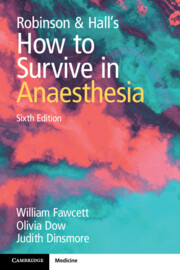Book contents
- Robinson & Hall’s How to Survive in Anaesthesia
- Robinson & Hall’s How to Survive in Anaesthesia
- Copyright page
- Contents
- Figures
- Tables
- Boxes
- Foreword
- Preface to the Sixth Edition
- Preface to the Fifth Edition
- Preface to the Fourth Edition
- Preface to the Third Edition
- Preface to the Second Edition
- Preface to the First Edition
- Abbreviations
- Let’s Start at the Very Beginning …
- Section 1 Nuts and Bolts
- Chapter 1 Evaluation of the Airway
- Chapter 2 Control of the Airway
- Chapter 3 Tracheal Intubation
- Chapter 4 The Difficult or Failed Intubation
- Chapter 5 Vascular Access
- Chapter 6 Pharmacology: A Brief Introduction
- Chapter 7 Intravenous Fluids
- Chapter 8 Anaesthetic Equipment: The Machine, Breathing Systems and Ventilators
- Chapter 9 Ultrasound in Anaesthesia and Intensive Care
- Chapter 10 Monitoring in Anaesthesia
- Chapter 11 Minimising Risk
- Section 2 Crises and Complications
- Section 3 Passing the Gas
- Section 4 Walking the Walk (and Talking the Talk)
- Section 5 And Finally …
- Index
Chapter 6 - Pharmacology: A Brief Introduction
from Section 1 - Nuts and Bolts
Published online by Cambridge University Press: 09 June 2025
- Robinson & Hall’s How to Survive in Anaesthesia
- Robinson & Hall’s How to Survive in Anaesthesia
- Copyright page
- Contents
- Figures
- Tables
- Boxes
- Foreword
- Preface to the Sixth Edition
- Preface to the Fifth Edition
- Preface to the Fourth Edition
- Preface to the Third Edition
- Preface to the Second Edition
- Preface to the First Edition
- Abbreviations
- Let’s Start at the Very Beginning …
- Section 1 Nuts and Bolts
- Chapter 1 Evaluation of the Airway
- Chapter 2 Control of the Airway
- Chapter 3 Tracheal Intubation
- Chapter 4 The Difficult or Failed Intubation
- Chapter 5 Vascular Access
- Chapter 6 Pharmacology: A Brief Introduction
- Chapter 7 Intravenous Fluids
- Chapter 8 Anaesthetic Equipment: The Machine, Breathing Systems and Ventilators
- Chapter 9 Ultrasound in Anaesthesia and Intensive Care
- Chapter 10 Monitoring in Anaesthesia
- Chapter 11 Minimising Risk
- Section 2 Crises and Complications
- Section 3 Passing the Gas
- Section 4 Walking the Walk (and Talking the Talk)
- Section 5 And Finally …
- Index
Summary
The safe administration of drugs is a key area in anaesthesia and intensive care. Ensuring patients receive the correct dose of the correct drug requires great care during the drawing up process (with any dilution required) and appropriate drug labelling. The anaesthetist must always remain vigilant for adverse drug reactions including anaphylaxis. Some of the drugs classes encountered maybe familiar to novices (such as opioids and some sedatives, antibiotics) but others will be less familiar (especially intravenous and volatile anaesthetic agents, both depolarising and non-depolarising neuromuscular blocking drugs, and nitrous oxide). Anaesthetists are often required to administer other drugs such as antibiotics, drugs affecting coagulation and drugs to assist imaging.
New areas are discussed, such as the transition away from nitrous oxide, desflurane and suxamethonium and the widespread use of sugammadex to reverse rocuronium, as well as the choice of total intravenous anaesthesia (TIVA) or volatile-based anaesthesia.
Keywords
Information
- Type
- Chapter
- Information
- Robinson and Hall's How to Survive in Anaesthesia , pp. 33 - 38Publisher: Cambridge University PressPrint publication year: 2025
Accessibility standard: Inaccessible, or known limited accessibility
Why this information is here
This section outlines the accessibility features of this content - including support for screen readers, full keyboard navigation and high-contrast display options. This may not be relevant for you.Accessibility Information
Content Navigation
Allows you to navigate directly to chapters, sections, or non‐text items through a linked table of contents, reducing the need for extensive scrolling.
Provides an interactive index, letting you go straight to where a term or subject appears in the text without manual searching.
Reading Order & Textual Equivalents
You will encounter all content (including footnotes, captions, etc.) in a clear, sequential flow, making it easier to follow with assistive tools like screen readers.
Visual Accessibility
You will still understand key ideas or prompts without relying solely on colour, which is especially helpful if you have colour vision deficiencies.
Structural and Technical Features
You gain clarity from ARIA (Accessible Rich Internet Applications) roles and attributes, as they help assistive technologies interpret how each part of the content functions.
